
DRESS & HISTORICAL ESCAPISM - THE DRESS RESEARCH EXHIBITION SERIES
Part 1 of 3: Dress Artifacts & Curatorial Practices
A Virtual (and Evolving) Exhibition
Anne Bissonnette, Lead Curator
Josée Chartrand and Katelin Karbonik, Contributing Curators
June 30, 2020 – June 30, 2021
Part 1 Home | The Blair Suit Reproduction | The Robe à la Française Reproduction | The Mid-1790s Chintz Gown | The Chemise Dress | The 1796 Reproduction Wedding Gown | The Housemaid's Dress
Chemise dress
White sprigged muslin (i.e. embroidered cotton plain weave), cotton or linen lining
Unknown creator and place of origin, late 1780s, 1790s, or early 1800s
Anne Lambert Clothing and Textiles Collection, Department of Human Ecology, University of Alberta
Purchased (2019.8.1)
Photographs, mount, and montage by Anne Bissonnette©
Few garments in the history of fashion have been as enticing to past and present viewers as the chemise dress. The “chemise dress” designation usually refers to a loose, unfitted “round gown” (i.e. not open in front from neck to hem) that resembles a linen chemise, or shift (Figure 1), the centuries-old, near-universal underwear for Western women. While many types of chemise dresses emerged in the last quarter of the 18th century (Figure 2), one of the most memorable is the fine cotton muslin chemise gown worn by Marie Antoinette (1755-1793) in her portrait by Élisabeth Louise Vigée Le Brun (1755-1842) (Figure 3). This portrait of the Queen in a white chemise dress provoked a scandal in the 1783 Paris Salon, as critics were aghast that “such a noble model could appear in such an intimate gown.”[1] It was not the only chemise dress style Vigée Le Brun depicted in her portraits and other fashionistas were, in comparison, much more audacious than the Queen.
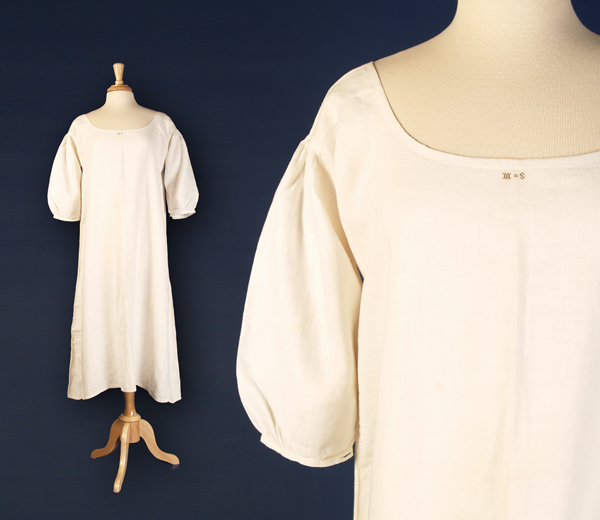
Figure 1
White linen shift
Unknown creator, British or European textile, garment worn in the United States of America, Massachusetts, late 18th century
Linen plain weave with the letters “M” (or “W”) and “S” embroidered in brown cross-stitches.
Worn by a member of the Wilber family of Swansea, Massachusetts.
Collection of Old Sturbridge Village, Sturbridge, Massachusetts (26.26.26).
Mount, photographs, and montage by Anne Bissonnette, courtesy of the Kent State University Museum.
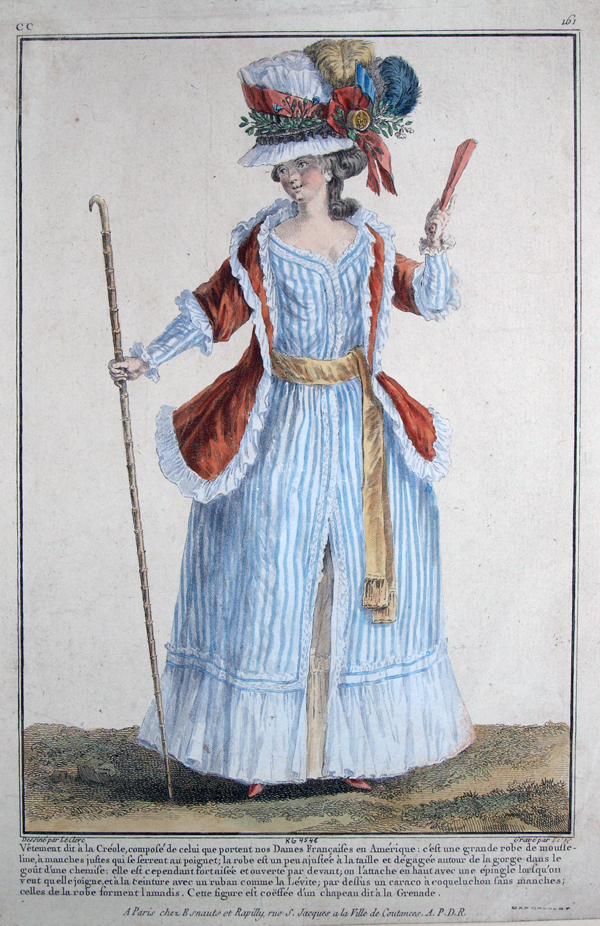
Figure 2
“Vêtement dit à la Créole…”
Drawn by LeClerc (Pierre-Thomas Leclère), engraved by Patas (Jean-Baptiste Patas)
Galerie des Modes, 27º Cahier de Costumes Français. 21º Suite d’Habillements à la Mode en 1779, excised plate “CC 161.”
Photograph by Anne Bissonnette© of an artifact in the collection of the Musée de la Mode et du Costume, Palais Galliera, Paris, France.
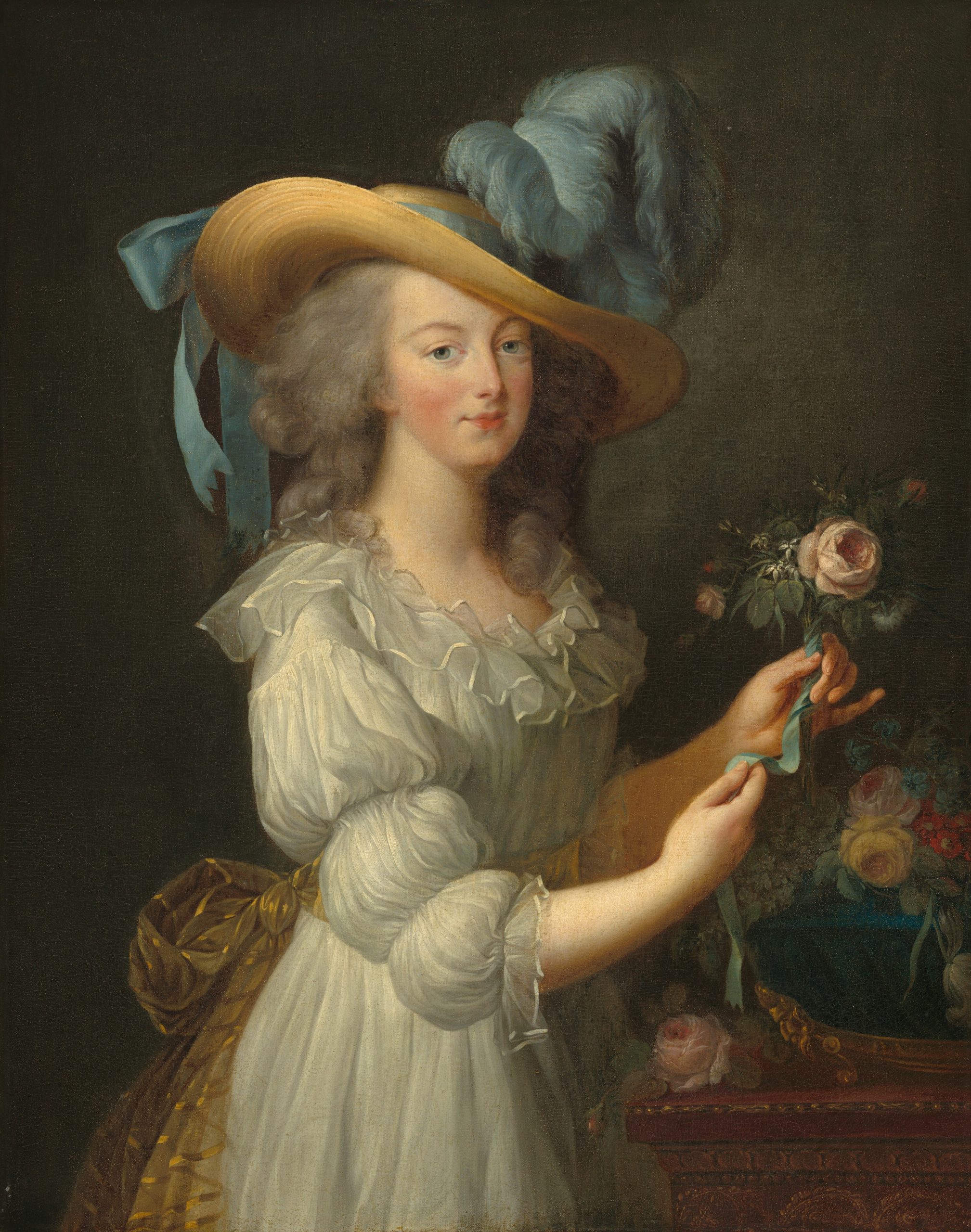
Figure 3
Marie Antoinette “en gaulle”
Anonymous artist, after Élisabeth-Louise Vigée Le Brun (1755-1842), after 1783
Original in a private collection, Hessische Hausstiftung, Kronberg, Germany.
This replica from the National Gallery of Art, Washington, Timken Collection (1960.6.41).
link to museum artifact
Styles of chemise gowns varied, as did the ways of wearing them. Some had fuller, three-quarter sleeves like a shift, others long, fitted sleeves. Some cinched the gown at the waist, others below the bust, as in the case of the Duchess de Polignac (1749–1793), captured by Vigée Le Brun in 1782. Unlike the Queen, who likely wears her gown over traditional conical stays and voluminous petticoats,[2] the Duchess’ collar is loosely tied in front, her gown shows no boned stays to compress her bosom at the front opening, and the skirt portion appears to be more columnal. This way of wearing a gown is an important departure from earlier 18th-century dress behaviors. The Duchess de Polignac’s chemise dress, like a shift, appears to be worn over a “natural body,” with individually delineated breasts―a mode of dressing we abide by today. The lack of both rigid, conical stays and voluminous petticoats pushes boundaries of propriety for 18th-century audiences but may go unnoticed by a 21st-century observer. If the Queen's 1783 portrait popularized a type of chemise dress that came to be known as a "chemise à la reine," many other styles of chemise dresses―and ways of wearing them (with or without conical stays)―existed before this date and after.
White round gowns with three-quarter or elbow-length sleeves, like the one in our exhibition, were most reminiscent of the shift but, early on, many types of chemise dresses were introduced that are worth describing in terms of cut and construction. A ca. 1781 Vigée Lebrun portrait of the Comtesse Du Barry (1743–1793), shows her in a white garment with a drop shoulder construction (a feature in the Queen’s and the Duchess’ gowns as well) and a ruffled collar similar to simple opened-front peignoirs and bed jackets that continue to be worn into the next century (Figure 4). Full-lengths, early chemise gowns in similar dropped sleeves and loose construction have not yet been found. Two early white cotton dresses have set-in sleeves sewn to narrow shoulder pieces that are more akin to 18th-century dress construction and closer to our artifact.
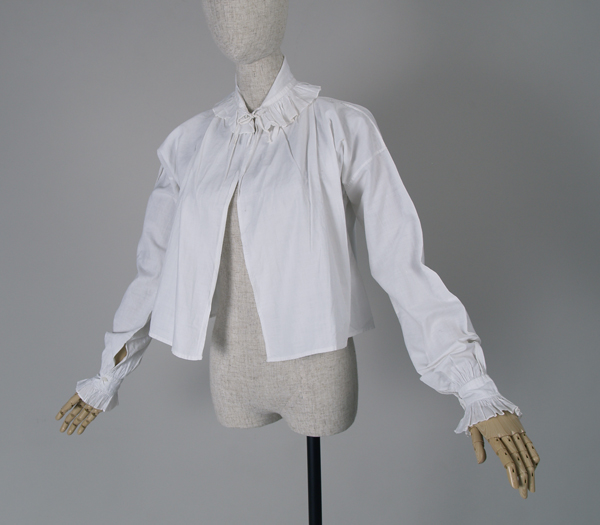
Figure 4
White cotton bed jacket
Cotton plain weave, late eighteenth to nineteenth century
Anne Lambert Clothing and Textile Collection, Department of Human Ecology, University of Alberta
Donated by Titi Halle, Cora Ginsburg LLLC (2019.9.46)
Mount and photograph by Anne Bissonnette©
The first artifact is an opened-front chemise dress in the collection of the Manchester Art Gallery. Its shoulder pieces are much narrower than those in our artifact. This narrow width leads to a wider round neckline in front. From the pattern made by Nora Waugh, the Manchester gown may have a low square neckline in back.[3] Waugh does not indicate the presence of a lining typical of gowns of this era, as is the case for our artifact. The Manchester gown’s three-quarter set-in sleeve is rather full and has a horizontal drawstring at the middle. This arm cinching is also seen in portraits through the use of coloured ties or ribbons. Apart from the shoulder piece and curved-head, gathered sleeve patterns, the last pattern piece covers the rest of the body and provides similar looseness seen in many 1780s portraits. This large pattern piece is only slightly inclined at the front neckline but curves at the underarm for the set-in sleeve. It has two sets of continuous horizontal drawstrings that gather the very fine “Jaindanie muslin from Dacca” across the diaphragm and waist.[4] The second early white cotton dress has similar horizontal drawstrings at the front bodice but has a fitted back.
A round gown of sprigged muslin from the Musée de la Toile de Jouy (Figures 5 and 6) has long, fitted, set-in sleeves attached to shoulder pieces, front panels with drawstrings at the neckline, diaphragm and waist, fitted sides and back, and an ample flounced skirt. The back is fitted through a series of stitched pleats rather than a diamond-back piece, like our artifact. The space between armholes is much wider on the Jouy piece compared with ours. The Jouy and the Manchester pieces have no trains while our does. They may all be described as chemise dresses but their construction differ from the ones from the 1780s depicted by Vigée Le Brun. Overall, it is rather reductive to talk about “the chemise dress” as there is a variety of such garments that require greater inquiry. Moreover, discussing “chemise dresses” and embodied behaviours should go hand in hand in scholarly research. Without a closer look at the cut and construction of an artifact or the depiction of a gown in a visual rendering, our interpretation of this broad category of dress is lacking.

Figures 5 and 6
White cotton chemise dress
Unknown creator and place of origins but likely French made, ca. 1787-1792
Sprigged muslin, cotton or linen lining
Musée de la Toile de Jouy (000.4.10)
Research photographs by Anne Bissonnette©**
**Please note that Figure 5 was digitally manipulated to unskew the visual. Sections of the table far from the gown’s shoulders were cloned to compensate for the skewing voids.
For instance, a closer observation of the skirt portion can suggest how our piece was worn. If all pieces can be mounted without voluminous petticoats, the presence of two pocket slits on the Jouy dress (Figure 6) and one pocket slit on the right side in our gown may suggest otherwise. Because the presence of typical 18th-century tie-on pockets would have added bulk that would disturb a linear silhouette, a fair amount of volume at the skirt of our artifacts is likely needed. Does less skirt volume necessarily mean the gown is much later? In Dr. Anne Bissonnette’s article, “Dessiné d'après nature : Renditions from Life in the Journal des Dames et des Modes , 1798‐9,” she used fashion plates to assess embodied practices. She concluded that, well into the 1790s “[d]ifferent styles and silhouettes coexist.”[5]
Other observations, comparisons and manipulation of artifacts can be informative too. The lining of the Jouy dress is 22.6 cm at the center front bodice while ours is only 10 cm. Lining pieces in both gown are flat and do not accommodate rounded, individually-delineated breasts. Despite the shorter lining, the way of wearing both these gowns is closer to Marie Antoinette’s, with conical stays that compress the bosom.
The maker of our gown and the original wearer that first commissioned the dress were joining past and present in its style and ways of wearing it. They followed a traditional dress construction path with the shoulder piece, set-in sleeve, shift-like cuff and volume of the sleeve, and flat-fronted lining meant to be worn over stays. The wearer also wore a voluminous petticoat that would hide the bulk from items in her tie-in pockets, accessible through the gown’s side slit. The width of the skit is, however, less than the Jouy dress and is likely narrower than that gown in silhouette. We cannot tell from the width at the hem and the elevated waist that the dress was, for certain, from the 1790s or early 1800s rather than the 1780s style of de Polignac’s gown but such features were more common later on. The fit in back is seen in the Jouy dress but our gown’s diamond-shape back and the narrow width between the sleeves is likely the most novel of its features. With all this knowledge at hand, how do we choose to mount our chemise dress for display?
Most viewers to an exhibition will only see one way of dressing a piece but a myriad of choices are possible that impact how the gown is read. Do we maximize the volume at the skirt or make it more columnal? Both can be done but, with the presence of the pocket slit, we gave the gown a fair amount of volume. The gown was tried on two mannequins: one without stays where the individualized rounded breasts can be delineated slightly (Figure 7) and one where stays were used (Figure 8). The gown fits better on stays. Sashes were customary on chemise gowns but what kind should we use: a narrow ribbon over the elevated seam (Figure 9) or a wider sash that is placed lower but covers surprisingly well the front and back seam (Figure 10)? With the documented evidence of cinching ribbons over the sleeves, do we add then (Figure 11) or err on the side of caution and omit them? By trying all these combinations, we may be pulled between what we want the outcome to be, what the artifacts suggests, and what story we wish to tell.
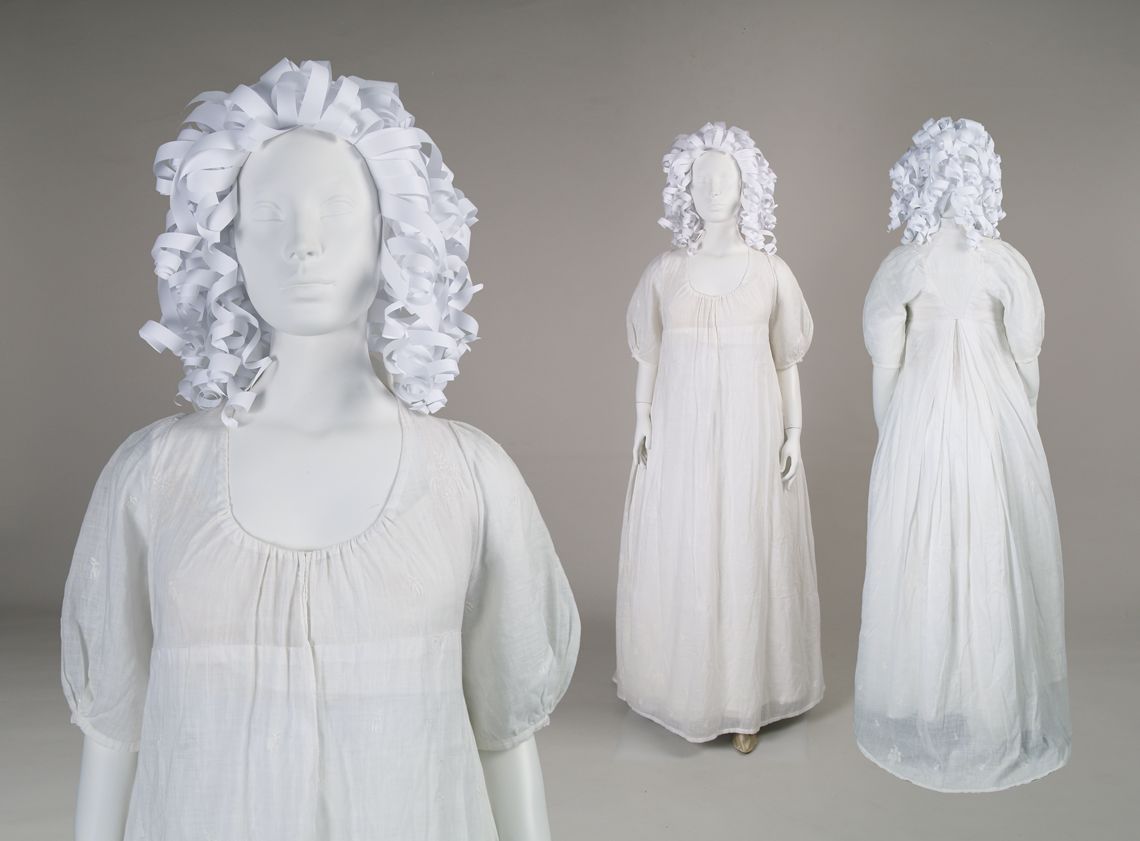
Figure 7
White chemise dress
Sprigged muslin (i.e. embroidered cotton plain weave), cotton or linen lining
Unknown maker and place of origin, late 1780s, 1790s, or early 1800s
Anne Lambert Clothing and Textiles Collection, Department of Human Ecology, University of Alberta
Purchased (2019.8.1)
Photographs, mount, and montage by Anne Bissonnette©
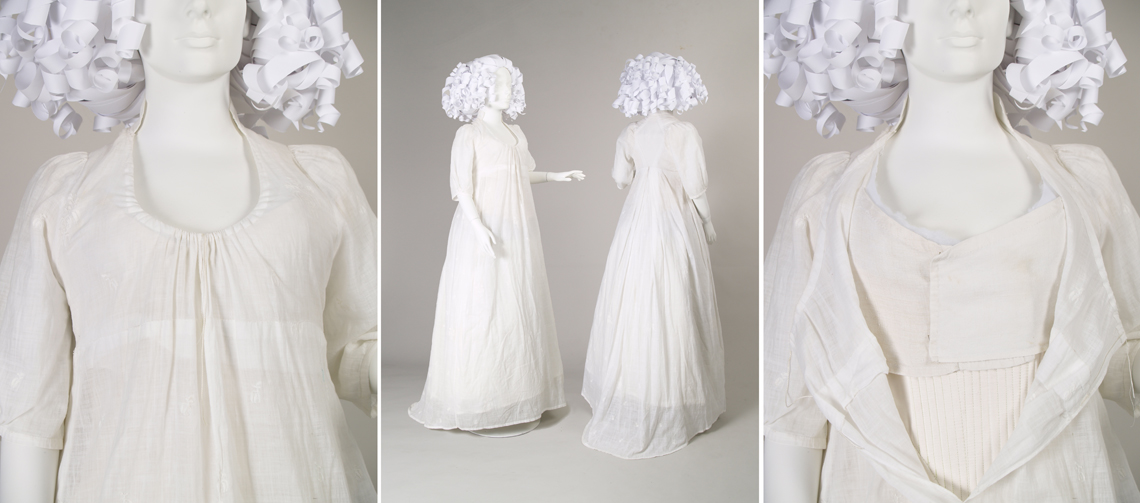
Figure 8
White chemise dress
Sprigged muslin (i.e. embroidered cotton plain weave), cotton or linen lining
Unknown maker and place of origin, late 1780s, 1790s, or early 1800s
Anne Lambert Clothing and Textiles Collection, Department of Human Ecology, University of Alberta
Purchased (2019.8.1)
Photographs, mount, and montage by Anne Bissonnette©

Figure 9
White chemise dress
Sprigged muslin (i.e. embroidered cotton plain weave), cotton or linen lining
Unknown maker and place of origin, late 1780s, 1790s, or early 1800s
Anne Lambert Clothing and Textiles Collection, Department of Human Ecology, University of Alberta
Purchased (2019.8.1)
Photographs, mount, and montage by Anne Bissonnette©
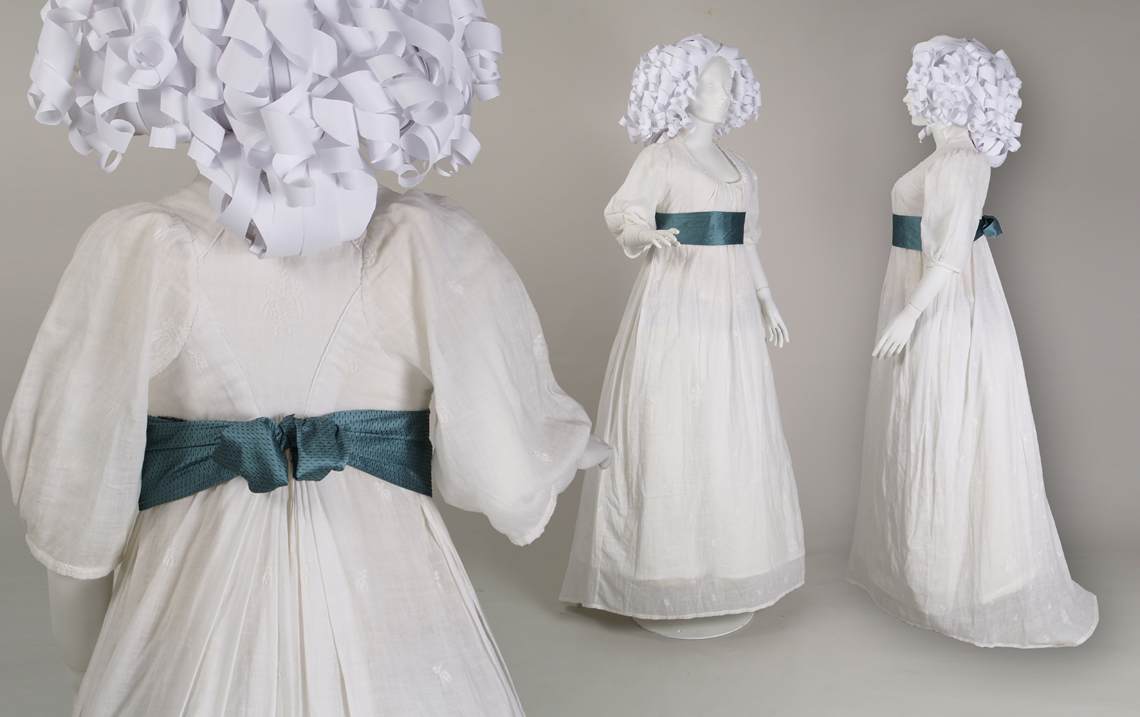
Figure 10
White chemise dress
Sprigged muslin (i.e. embroidered cotton plain weave), cotton or linen lining
Unknown maker and place of origin, late 1780s, 1790s, or early 1800s
Anne Lambert Clothing and Textiles Collection, Department of Human Ecology, University of Alberta
Purchased (2019.8.1)
Photographs, mount, and montage by Anne Bissonnette©
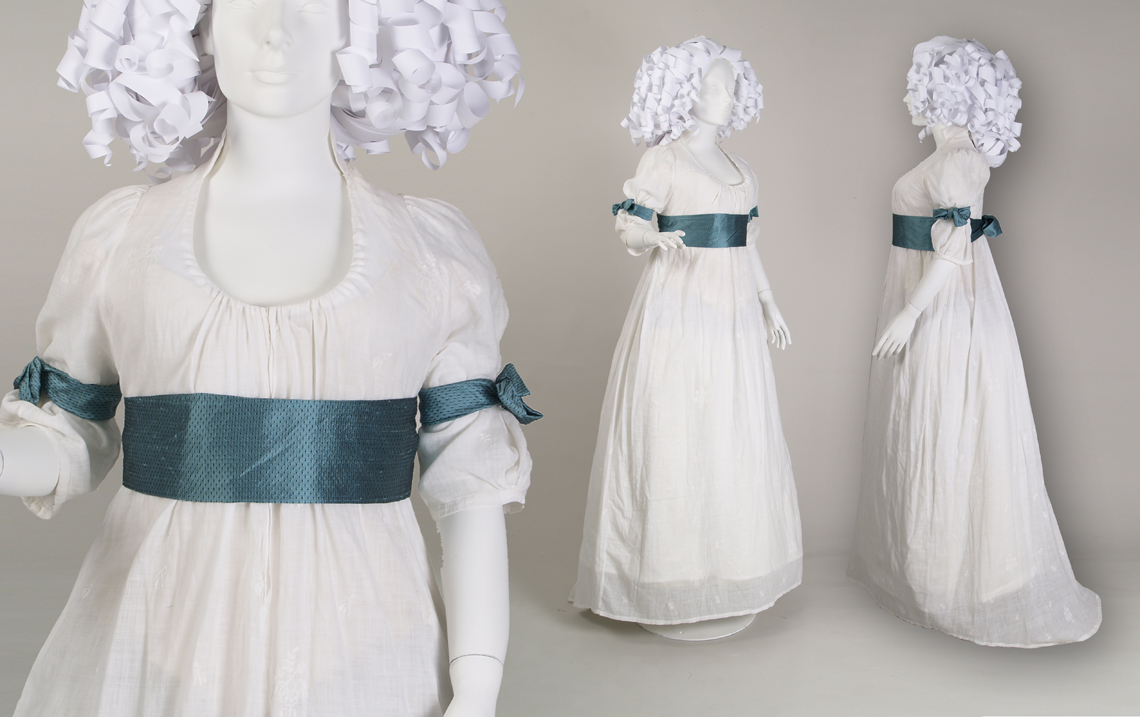
Figure 11
White chemise dress
Sprigged muslin (i.e. embroidered cotton plain weave), cotton or linen lining
Unknown maker and place of origin, late 1780s, 1790s, or early 1800s
Anne Lambert Clothing and Textiles Collection, Department of Human Ecology, University of Alberta
Purchased (2019.8.1)
Photographs, mount, and montage by Anne Bissonnette©
Do you know of other dress artifacts that are presented in ways that may affect how they are read or interpreted?
Share your thoughts by e-mailing anne.bissonnette@ualberta.ca and we may add your story to bring different perspectives on this subject.
[1] Painting portraits of Marie-Antoinette, Réunion des musées nationaux – Grand Palais Website, 17 November 2015, https://www.grandpalais.fr/en/article/painting-portraits-marie-antoinette-0.
[2] Anne Bissonnette, "Marie Louise Renée de Charnay, Co-seigneuresse of Kamouraska, and Transitional 1790s Dress/Marie-Louise Renée de Charnay, co‑seigneuresse de Kamouraska, et les tenues transitionnelles des années 1790," National Gallery of Canada Review 10 (2019): 6, https://ngcr.utpjournals.press/doi/full/10.3138/ngcr.10-001.
[3] How the volume is secured is not known as there is no casing for a drawstring. Norah Waugh, The Cut of Women's Clothes: 1600-1930 (Faber and Faber Limited, London, 1968, reprinted by Faber and Faber Limited, London, 1973), 98 (Diagram XXV).
[4] Dress (Chemise À La Reine), Manchester Art Gallery, https://manchesterartgallery.org/collections/title/?mag-object-12379.
[5] Anne Bissonnette, “Dessiné d'après nature: Renditions from Life in the Journal des Dames et des Modes, 1798‐9," Journal for Eighteenth‐Century Studies 38, no. 2 (2015): 227, https://onlinelibrary.wiley.com/doi/full/10.1111/1754-0208.12205.
Support for the exhibition was provided by a KIAS Dialogue Grant from the Kule Institute for Advanced Study and a CIP Artist Project Grant by the Edmonton Arts Council and the City of Edmonton.



This exhibition draws on research supported by the Social Sciences and Humanities Research Council. The following individuals have contributed to Dr. Bissonnette’s research thus far: Josée Chartrand, Meg Furler, Peggy Isley, Katelin Karbonik, Patricia Siferd, and Sarah Woodyard.
